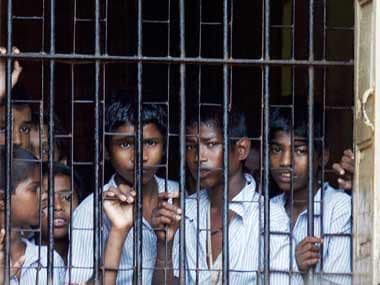By Preeti Jacob and Shekhar Seshadri
The Juvenile Justice Amendment Bill of 2015 was passed in the Lok Sabha on 7 May, 2015 despite being vociferously opposed by child rights activists all over the country. Many aspects of this law are unsettling and worrisome; one of them being the fact that more juveniles will be incarcerated as the Act promotes the adoption of a retributive and punitive stance against them. Under the newly amended law, adolescents alleged to have committed a heinous crime will be confined to a “place of safety”, which is essentially a place of imprisonment, both during the period of inquiry and after the conviction.
Regrettably, the term “place of safety” may turn out to be something of a terminological inexactitude, simply because they don’t currently exist and thus these children may actually be housed in a part of the adult prison. The bill also proposes that adolescents in “places of safety” at the age of 21 years would be transferred to adult prison for the remainder of their sentence if the adult court deems that they have not been suitably “reformed” and are not likely to become “contributing members of society”.
[caption id=“attachment_2209190” align=“alignleft” width=“380”]  Juvenile remand home. Reuters[/caption]
Under the current law (the amended bill is pending in the Rajya Sabha), adolescents convicted of a heinous crime were housed in what was referred to as a special home, where reformative activities and inputs were supposed to be made available. The juvenile homes failed to live up to these noble principles in their functioning, and did not uphold the Juvenile Justice (Care and Protection) Act 2000 in letter or spirit.
A study of the juvenile homes in various parts of the country done by Asian Centre for Human Rights and published in March 2013 found that the ‘inmates’ of these homes were housed in “inhuman conditions”. Disturbing incidents of sexual abuse and assault, exploitation, and torture were documented during the study, irrespective of whether the home was run by the government or private agencies. Perpetrators included caretakers, cooks, other Class IV employees, directors, founders, senior inmates, etc.
Impact Shorts
More ShortsThese ‘inmates’ were often subjected to chronic physical and sexual abuse often for years, bearing their physical and emotional scars in silent anguish. Sexual abuse and victimisation is a vicious cycle; children and adolescents who have experienced sexual abuse frequently get trapped in subsequent abusive relationships and at times can even perpetrate sexual crimes. Thus, institutions dedicated to principles of rehabilitation, reformation and reintegration of a juvenile turned into homes of degradation and further despair. How are the new “places of safety” likely to be any different, if not worse, when even the law on paper is more punitive in nature?
The other questions that need to be answered in light of the new amendments are,
whether incarceration works as a deterrent, and
what the long term impact of incarceration is both for crime rates, and thereby for the larger community?
The United States of America has for some time adopted laws that allow juveniles to be tried as adults. They also have one of highest rates of juvenile incarceration among the developed countries. Research in this population now suggests that alternatives other than incarceration are probably more beneficial in the long run. Studies by Aizer and Doyle (2013) and Usher (2013) have shown that juveniles who were incarcerated had higher rates of recidivism and poorer educational attainments than juveniles who were not detained in correctional institutions.
Aizer and Doyle (2013) have also reported that states in the US which instituted community based alternatives to incarceration had less crime. David Farrington (1977) reported that youth who were incarcerated constructed a “deviant self-image” which caused them to continue or increase their involvement in crime subsequently.
If we transfer children to adult prison it will have long lasting and catastrophic effects. Incarceration puts the child at risk for various kinds of abuse especially in the adult criminal justice system which will have long term sequelae. The criminogenic effect of incarcerating juveniles with adult prisoners has also been reported in studies.
By taking away the crucial years of adolescence where reformation is possible, we as a society are essentially condemning these children to a life of crime and to a life in and out of jail. With the current evidence that we have, how is transfer going to serve the purpose of making society safer? Transfer to the adult criminal justice system has neither proven to be a big enough deterrent nor has it reduced recidivism. Must we then adopt systems that have not demonstrated to be adequate even in developed countries?
Juveniles do need to be held accountable for the crimes they commit but the approaches and systems employed have to be developmentally appropriate (though the science of developmental maturity is beyond the scope of this article, its dissonance with the current law deserves to be mentioned). Thus, transfer to the adult criminal justice system will ensure that rehabilitation and reformation are improbable goals.
The Juvenile Justice (Care and Protection) Act, 2000 was a progressive piece of legislation with its heart in the right place. The need of the hour is to fix the systemic problems and strengthen the existing juvenile justice system such that it can fulfil its objectives to reform and rehabilitate the young people who need it the most.
*Preeti Jacob is an Assistant Professor in the Department of Child & Adolescent Psychiatry, NIMHANS. Shekhar Seshadri is a Professor in the Department of Child & Adolescent Psychiatry at NIMHANS


)

)
)
)
)
)
)
)
)



